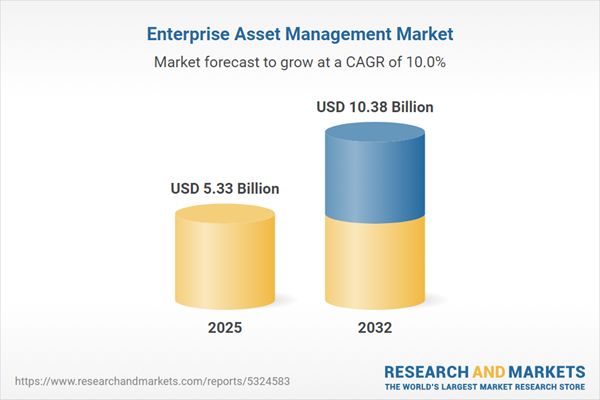Speak directly to the analyst to clarify any post sales queries you may have.
Enterprise asset management (EAM) now sits at the strategic center of modern organizations, enabling senior leaders to navigate complexity, enhance operational resilience, and ensure alignment between asset performance and broader business goals. These capabilities are increasingly vital as executive teams face shifting regulatory landscapes and rising expectations for transparency and efficiency.
Market Snapshot: Enterprise Asset Management Market
The enterprise asset management market is experiencing sustained growth as modernization intensifies across industries. Recent projections highlight a notable increase in value, with the market expected to expand from USD 4.85 billion in 2024 to USD 5.33 billion in 2025. Over the longer term, forecasts anticipate the sector reaching USD 10.38 billion by 2032, representing a compound annual growth rate (CAGR) of 9.97%.
Accelerating investments in EAM tools and platforms are empowering organizations to make real-time decisions, streamline asset lifecycle processes, and adapt reliably to ongoing fluctuations in supply chains and regulatory requirements. Increasingly, EAM systems are integral to corporate strategy, underpinning efficiency and resilient operations in asset-intensive environments.Scope & Segmentation
This report offers actionable insight for executive leaders looking to refine asset management strategies and support informed, data-driven planning. The segmentation below provides a foundation for customized approaches and market benchmarking:
- Organization Size: Large enterprises, mid-market firms, and small businesses manage diverse resource requirements, each demanding tailored EAM strategies that reflect unique operational and business objectives.
- Deployment Mode: Cloud-based, public cloud, private cloud, and on-premise deployment options give organizations flexibility to address compliance, IT integration, and risk management challenges as they adapt their infrastructure and security protocols.
- Component: Both software and related enabling services, including consulting and workforce development, are incorporated to provide solutions that adapt to the technical and organizational context of each business.
- Asset Type: Oversight extends to facilities, infrastructure, production equipment, and transportation fleets, supporting holistic asset management and promoting long-term value through enhanced visibility.
- Industry Vertical: Sectors such as energy, utilities, healthcare, manufacturing, mining, oil and gas, and logistics benefit from EAM technology that aligns with industry regulations and performance drivers.
- Regional Coverage: The report examines the Americas, Europe, Middle East & Africa, and Asia-Pacific, providing nuanced analysis of regional technology adoption, business strategies, and local compliance pressures.
- Key Companies: Industry standards and benchmarks reflect developments from IBM, SAP, Oracle, Infor, IFS, Schneider Electric, ABB, GE, Hexagon, and Bentley Systems, each setting practical approaches relevant to asset-heavy sectors.
This detailed segmentation enables organizations to align asset management agendas with compliance requirements, the impact of emerging technologies, and evolving business priorities across operational scales.
Key Takeaways for Senior Decision-Makers
- Advanced analytics and real-time visibility drive faster identification of asset reliability risks, minimizing disruptions and supporting operational stability.
- Industry-tailored enterprise asset management platforms help streamline compliance efforts and boost performance in specialized regulatory environments.
- Emerging technologies such as digital twins and augmented reality facilitate remote asset oversight, enable targeted workforce training, and strengthen organizational resilience even with changing talent pools.
- Integrated data flows across departments improve transparency, allowing for timely, evidence-based decisions that sharpen focus on asset efficiency.
- The increasing prioritization of data governance steers many organizations toward private cloud and on-premise solutions to address compliance and heighten information security.
Tariff Impact and Global Sourcing Shifts
Changes in tariff environments are prompting organizations to revisit sourcing practices for mission-critical assets and supply chain processes. By shifting towards nearshoring and increasing supplier diversification, companies sustain operational continuity in variable market conditions. Procurement transparency and the strategic renovation of existing assets also play a significant role in supporting agile and robust supply strategies.
Methodology & Data Sources
This analysis draws from interviews with senior asset management and procurement professionals, assessments of technical documentation, and comparative benchmarks from leading EAM vendors. This multifaceted approach ensures that findings are echoed by current executive priorities and match industry standards.
Why This Report Matters
- Enables the integration of asset management systems with core IT and workforce initiatives, improving compliance and operational agility.
- Provides executive models for adaptive supply chain management to enhance organizational resilience and support sustainable growth with streamlined EAM implementation.
- Offers region-specific guidance to help organizations maximize value whether operating in established or rapidly-emerging markets.
Conclusion
This report gives senior leaders robust frameworks to refine asset management, ensuring organizations respond effectively to evolving industry demands while building sustainable operational advantages.
Additional Product Information:
- Purchase of this report includes 1 year online access with quarterly updates.
- This report can be updated on request. Please contact our Customer Experience team using the Ask a Question widget on our website.
Table of Contents
3. Executive Summary
4. Market Overview
7. Cumulative Impact of Artificial Intelligence 2025
Companies Mentioned
The companies profiled in this Enterprise Asset Management market report include:- International Business Machines Corporation
- SAP SE
- Oracle Corporation
- Infor, Inc.
- IFS AB
- Schneider Electric SE
- ABB Ltd
- General Electric Company
- Hexagon AB
- Bentley Systems, Incorporated
Table Information
| Report Attribute | Details |
|---|---|
| No. of Pages | 183 |
| Published | October 2025 |
| Forecast Period | 2025 - 2032 |
| Estimated Market Value ( USD | $ 5.33 Billion |
| Forecasted Market Value ( USD | $ 10.38 Billion |
| Compound Annual Growth Rate | 9.9% |
| Regions Covered | Global |
| No. of Companies Mentioned | 11 |









